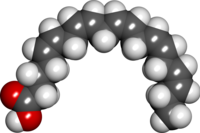Eicosapentaenoic acid/ja: Difference between revisions
Created page with "魚類はほとんどの脊椎動物と同様に、食餌性のα-リノレン酸(ALA)からEPAをほとんど合成できない。このように変換率が極めて低いため、魚類は主に摂取した藻類からEPAを摂取している。EPAは動物以外からも摂取可能である(例えば、''Yarrowia lipolytica''や''Nannochloropsis oculata''、''Monodus subterraneus''、''Chlorel..." Tags: Mobile edit Mobile web edit |
No edit summary Tags: Mobile edit Mobile web edit |
||
| (14 intermediate revisions by the same user not shown) | |||
| Line 58: | Line 58: | ||
魚類はほとんどの脊椎動物と同様に、食餌性の[[alpha-linolenic acid/ja|α-リノレン酸]](ALA)からEPAをほとんど合成できない。このように変換率が極めて低いため、魚類は主に摂取した[[algae/ja|藻類]]からEPAを摂取している。EPAは動物以外からも摂取可能である(例えば、''[[Yarrowia lipolytica/ja|Yarrowia lipolytica]]''や''Nannochloropsis oculata''、''Monodus subterraneus''、''Chlorella minutissima''、''[[Phaeodactylum tricornutum/ja|Phaeodactylum tricornutum]]''などの[[microalgae/ja|微細藻類]]が商業的に開発されている)。EPAは通常、高等植物には含まれていないが、[[Portulaca oleracea/ja|パースレーン]]には微量含まれていることが報告されている。2013年には、[[Camelina sativa/ja|カメリーナ]]という植物の遺伝子組み換え体から、かなりの量のEPAが生産されることが報告された。 | 魚類はほとんどの脊椎動物と同様に、食餌性の[[alpha-linolenic acid/ja|α-リノレン酸]](ALA)からEPAをほとんど合成できない。このように変換率が極めて低いため、魚類は主に摂取した[[algae/ja|藻類]]からEPAを摂取している。EPAは動物以外からも摂取可能である(例えば、''[[Yarrowia lipolytica/ja|Yarrowia lipolytica]]''や''Nannochloropsis oculata''、''Monodus subterraneus''、''Chlorella minutissima''、''[[Phaeodactylum tricornutum/ja|Phaeodactylum tricornutum]]''などの[[microalgae/ja|微細藻類]]が商業的に開発されている)。EPAは通常、高等植物には含まれていないが、[[Portulaca oleracea/ja|パースレーン]]には微量含まれていることが報告されている。2013年には、[[Camelina sativa/ja|カメリーナ]]という植物の遺伝子組み換え体から、かなりの量のEPAが生産されることが報告された。 | ||
ヒトの体内では、吸収された[[alpha-linolenic acid/ja|α-リノレン酸]](ALA)の一部がEPAに変換される。ALAはそれ自体が必須脂肪酸であり、ヒトは適切な供給を必要としている。しかし、ALAからEPAへの変換効率は、EPAを含む食品からのEPAの吸収に比べるとはるかに低い。EPAは[[docosahexaenoic acid/ja|ドコサヘキサエン酸]](DHA)の[[Precursor (chemistry)/ja|前駆体]]でもあるため、EPAもDHAも含まない食事で十分なEPA量を確保することは、EPAを合成するために必要な余分な代謝作業と、DHAへの代謝にEPAを使用するため、どちらも難しくなる。また、[[diabetes mellitus/ja|糖尿病]]や特定のアレルギーのような医薬品は、人体がALAからEPAを代謝する能力を著しく制限する可能性がある。 | |||
== 形態{{Anchor|Forms}}== | |||
== Forms == | 市販されている栄養補助食品は、魚油由来のものが最も多く、トリグリセリド型、エチルエステル型、リン脂質型のEPAが一般的である。サプリメントメーカーの間では、各形態の相対的な長所と短所について議論が交わされている。藻類に天然に存在する極性脂質の形態は、エチルエステルやトリグリセリドの形態よりも生物学的利用能が向上していることが示されている。同様に、2020年の研究では、[[lysophosphatidylcholine/ja|リゾホスファチジルコリン]](LPC)形態のDHAまたはEPAは、トリグリセリドおよび[[phosphatidylcholine/ja|ホスファチジルコリン]](PC)よりも効率的であることが判明した。 | ||
{| class="wikitable sortable" style="width: auto;" | {| class="wikitable sortable" style="width: auto;" | ||
|- | |- | ||
! | ! ベース | ||
! EPA | ! EPA | ||
|- | |- | ||
! [[Omega-3 acid ethyl esters| | ! [[Omega-3 acid ethyl esters/ja|エチルエステル]] | ||
| [[Ethyl eicosapentaenoic acid| | | [[Ethyl eicosapentaenoic acid/ja|EPAエチルエステル]] | ||
|- | |- | ||
! [[Lysophosphatidylcholine]] (LPC, | ! [[Lysophosphatidylcholine/ja]] (LPC, あるいは lysoPC) | ||
| LPC-EPA, | | LPC-EPA, あるいは lysoPC-EPA | ||
|- | |- | ||
! [[Phosphatidylcholine]] (PC) | ! [[Phosphatidylcholine/ja]] (PC) | ||
| EPA-PC | | EPA-PC | ||
|- | |- | ||
! [[Phospholipid]] (PL) | ! [[Phospholipid/ja]] (PL) | ||
| EPA-PL | | EPA-PL | ||
|- | |- | ||
! [[Triglyceride]] (TG) | ! [[Triglyceride/ja]] (TG) あるいは トリアシルグリセロール (TAG) | ||
| EPA-TG, | | EPA-TG, あるいは EPA-TAG | ||
|- | |- | ||
! | ! 再エステル化[[triglyceride/ja|トリグリセリド]](rTG)、または再エステル化トリアシルグリセロール(rTAG) | ||
| EPA rTG, | | EPA rTG, あるいは r-TAG | ||
|} | |} | ||
== 生合成{{Anchor|Biosynthesis}} == | |||
== Biosynthesis == | === 好気性真核生物による経路 === | ||
=== | [[File:Overview of biosynthesis of EPA.png|thumb|upright=1.5|好気性真核生物の[[fatty acid synthesis/ja|脂肪酸合成]]を介したEPA]] | ||
[[File:Overview of biosynthesis of EPA.png|thumb|upright=1.5| | 好気性真核生物、具体的には微細藻類、[[moss/ja|コケ]]類、[[fungus/ja|菌類]]、およびほとんどの動物(ヒトを含む)は、通常、デサチュラーゼとエロンガーゼ[[enzyme/ja|酵素]]の連続的な作用によって触媒される一連の脱飽和反応と伸長反応としてEPAの生合成を行う。もともと''Thraustochytrium''で同定されたこの経路は、これらのグループに当てはまる: | ||
# [[delta 6 desaturase/ja|Δ6デサチュラーゼ]]によって[[α-Linolenic acid/ja|α-リノレン酸]]の6番目の炭素で脱飽和が起こり、[[stearidonic acid/ja|ステアリドン酸]](SDA、18:4 ω-3)が生成される、 | |||
# | # Δ6エロンガーゼによって[[stearidonic acid/ja|ステアリドン酸]]が伸長され、[[eicosatetraenoic acid/ja|エイコサテトラエン酸]](ETA、20:4 ω-3)が生成される、 | ||
# | # [[delta 5 desaturase/ja|Δ5デサチュラーゼ]]によって[[eicosatetraenoic acid/ja|エイコサテトラエン酸]]の5番目の炭素で脱飽和し、[[eicosapentaenoic acid/ja|エイコサペンタエン酸]](EPA、20:5 ω-3)を生成する、 | ||
# | |||
{{clear}} | {{clear}} | ||
=== ポリケチド合成酵素経路=== | |||
=== | 海洋細菌や微細藻類''[[Schizochytrium/ja|Schizochytrium]]''は、好気性[[polyketide synthase/ja|ポリケチド合成酵素]](PKS)経路を用いてDHAを合成する。PKS経路には6つの酵素、すなわち3-ケトアシルシンターゼ(KS)、2-ケトアシル-ACP-レダクターゼ(KR)、デヒドラーゼ(DH)、エノイルレダクターゼ(ER)、デヒドラターゼ/2-トランス 3-cosイソメラーゼ(DH/2,3I)、デヒドラターゼ/2-トランス、2-cisイソメラーゼ(DH/2,2I)が含まれる。EPAの生合成は海洋種によって異なるが、C18[[PUFA/ja|PUFA]]をLC-PUFAに変換する海洋種の能力のほとんどは、脂肪アシルデサチュラーゼとエロンガーゼ酵素に依存している。酵素の分子基盤は、得られる分子上の二重結合が形成される場所を決定する。 | ||
海洋細菌であるシェワネラ(''Shewanella'')が提唱するEPAのポリケチド合成経路は、アセチルCoAとマロニルCoAを構成要素として、還元、脱水、縮合を繰り返す反応である。α-リノレン酸からEPAへの変換機構は、KSによって既存のα-リノレン酸にマロニルCoAが縮合する。得られた構造は、NADPH依存性還元酵素KRによって変換され、DH酵素によって脱水された中間体を形成する。最終段階は、ER酵素活性によってトランス-2-エノリ-ACPの二重結合がNADPH依存的に還元される。この過程を繰り返してEPAが形成される。 | |||
{{clear}} | {{clear}} | ||
==臨床的意義{{Anchor|Clinical significance}}== | |||
==Clinical significance== | {{Further/ja|Essential fatty acid interactions/ja}} | ||
{{Further|Essential fatty acid interactions}} | [[File:Röding, Iduns kokbok.jpg|thumb|right|250px|[[salmon/ja|サーモン]]はEPAの豊富な供給源である。]] | ||
[[File:Röding, Iduns kokbok.jpg|thumb|right|250px|[[ | 米国[[:en:National Institute of Health|国立衛生研究所]]のMedlinePlusには、EPA(単独または他のω-3源と併用)が効果的な治療法であることが知られている、または考えられている病状が掲載されている。これらのほとんどは、[[inflammation/ja|炎症]]を低下させるその能力に関わっている。 | ||
長鎖オメガ3脂肪酸を処方薬や栄養補助食品として大量(2.0~4.0g/日)摂取することは、一般的にトリグリセリドの有意な低下(15%以上)を達成するために必要であり、その摂取量では、その効果は有意なものとなる(20%~35%、500 mg/dLを超える人では最大45%)。 | |||
EPAとDHAを含む栄養補助食品は、用量依存的にトリグリセリドを低下させるが、DHAは[[low-density lipoprotein/ja|低密度リポタンパク質]](アテローム性動脈硬化を促進する変異体であり、不正確に「悪玉コレステロール」と呼ばれることもある)と[[LDL-C/ja|LDL-C]]値(LDL粒子内のコレステロール量の測定値/推定値)を上昇させるようであるが、EPAは上昇させない。この効果は、EPAとDHAの両方が高用量のオメガ3サプリメントの一部であった数百の個々の臨床試験を組み合わせたいくつかの[[Meta-analysis/ja|メタアナリシス]]で見られているが、それは違いが明確に見ることができるEPAとDHAを別々に与えられた場合である。例えば、タフツ医科大学のシェーファーらの研究では、患者に600 mg/日のDHA単独、600または1800 mg/日のEPA単独、またはプラセボを6週間投与した。DHA投与群では、トリグリセリドが20%有意に低下し、LDL-Cが18%上昇したが、EPA投与群では、トリグリセリドの小幅な低下は統計学的に有意とはみなされず、LDL-C値にはいずれの投与量でも変化は認められなかった。 | |||
一般消費者は、脂ののった魚などの食品からEPAとDHAを摂取するのが魚油の栄養補助食品、およびあまり一般的ではない[[seaweed oil/ja|藻類油]]サプリメントからのオメガ3用量は、臨床実験のものよりも低い。9253人の健康な男女を10年間追跡したクーパー・センター縦断研究によって、魚油サプリメントを摂取した人はLDL-C値が上昇しなかったことが明らかになった。実際、LDL-Cのごくわずかな「減少」がみられ、統計的には有意であったが、臨床的な意義というには小さすぎた。これらの人々は自分で選んだ魚油サプリメントを摂取しており、EPAとDHAの量と比率は魚油の供給源によって異なることを認識すべきである。 | |||
オメガ3脂肪酸、特にEPAは、[[autistic spectrum disorder/ja|自閉症スペクトラム障害]](ASD)に対する効果が研究されている。自閉症児ではオメガ3脂肪酸レベルが低い可能性があるため、サプリメントの摂取が症状の改善につながるかもしれないという理論もある。いくつかの非対照研究では改善が報告されているが、十分に統制された研究では、高用量のオメガ3サプリメントの摂取による症状の統計的に有意な改善は示されていない。 | |||
さらに、オメガ3脂肪酸が[[Depression (mood)/ja|うつ病]]の治療に有用である可能性があることが研究で示されている。 | |||
EPAとDHAの[[ethyl ester/ja|エチルエステル]](全形態)は、空腹時または低脂肪食と一緒に摂取すると、吸収率が低下し、効きが悪くなる可能性がある。 | |||
==注釈== | ==注釈== | ||
Latest revision as of 20:42, 14 April 2024

| |
| Names | |
|---|---|
| Preferred IUPAC name
(5Z,8Z,11Z,14Z,17Z)-Icosa-5,8,11,14,17-pentaenoic acid | |
| Other names
(5Z,8Z,11Z,14Z,17Z)-5,8,11,14,17-eicosapentaenoic acid
| |
| Identifiers | |
3D model (JSmol)
|
|
| 3DMet | |
| 1714433 | |
| ChEBI | |
| ChEMBL | |
| ChemSpider | |
| DrugBank | |
| KEGG | |
PubChem CID
|
|
| UNII | |
| |
| |
| Properties | |
| C20H30O2 | |
| Molar mass | 302.451 g/mol |
| Hazards | |
| GHS labelling: | |

| |
| Danger | |
| H314 | |
| P260, P264, P280, P301+P330+P331, P303+P361+P353, P304+P340, P305+P351+P338, P310, P321, P363, P405, P501 | |
エイコサペンタエン酸(EPA、icosapentaenoic acid)は、オメガ3脂肪酸の一種である。生理学的な文献では20:5(n-3)と呼ばれている。また、慣用名としてチムノドン酸がある。化学構造では、EPAは20炭素鎖と5つのシスを持つカルボン酸二重結合はω末端から3番目の炭素に位置する。
EPAは、プロスタグランジン-3(血小板凝集を抑制する)、トロンボキサン-3、ロイコトリエン-5の前駆体として働く多価不飽和脂肪酸(PUFA)である。エイコサノイド類である。EPAは前駆体であると同時に加水分解物質でもある。エイコサペンタエノイルエタノールアミド(EPEA:C22H35NO2; 20:5,n-3)の分解産物である。 ドコサヘキサエン酸(DHA)とEPAの両方を含む魚油サプリメントの研究では、心筋梗塞や脳卒中を予防するという主張を裏付けることはできなかったが、バセパ(エチルエイコサペンタエン酸、エチルエステル、遊離脂肪酸エステル)、EPAのみを含む処方薬物であるが、スタチン抵抗性高トリグリセリド血症の患者において、プラセボと比較して心臓発作、脳卒中、心血管死を25%減少させることが示された。
摂取源
EPAは、タラ肝、ニシン、サバ、サケ、メンヘデン、イワシなどの脂ののった魚、さまざまな種類の食用藻類を食べることによって、あるいは魚油や藻類油のサプリメントを摂取することによって、ヒトの食事から得られる。また、ヒトの母乳にも含まれている。
魚類はほとんどの脊椎動物と同様に、食餌性のα-リノレン酸(ALA)からEPAをほとんど合成できない。このように変換率が極めて低いため、魚類は主に摂取した藻類からEPAを摂取している。EPAは動物以外からも摂取可能である(例えば、Yarrowia lipolyticaやNannochloropsis oculata、Monodus subterraneus、Chlorella minutissima、Phaeodactylum tricornutumなどの微細藻類が商業的に開発されている)。EPAは通常、高等植物には含まれていないが、パースレーンには微量含まれていることが報告されている。2013年には、カメリーナという植物の遺伝子組み換え体から、かなりの量のEPAが生産されることが報告された。
ヒトの体内では、吸収されたα-リノレン酸(ALA)の一部がEPAに変換される。ALAはそれ自体が必須脂肪酸であり、ヒトは適切な供給を必要としている。しかし、ALAからEPAへの変換効率は、EPAを含む食品からのEPAの吸収に比べるとはるかに低い。EPAはドコサヘキサエン酸(DHA)の前駆体でもあるため、EPAもDHAも含まない食事で十分なEPA量を確保することは、EPAを合成するために必要な余分な代謝作業と、DHAへの代謝にEPAを使用するため、どちらも難しくなる。また、糖尿病や特定のアレルギーのような医薬品は、人体がALAからEPAを代謝する能力を著しく制限する可能性がある。
形態
市販されている栄養補助食品は、魚油由来のものが最も多く、トリグリセリド型、エチルエステル型、リン脂質型のEPAが一般的である。サプリメントメーカーの間では、各形態の相対的な長所と短所について議論が交わされている。藻類に天然に存在する極性脂質の形態は、エチルエステルやトリグリセリドの形態よりも生物学的利用能が向上していることが示されている。同様に、2020年の研究では、リゾホスファチジルコリン(LPC)形態のDHAまたはEPAは、トリグリセリドおよびホスファチジルコリン(PC)よりも効率的であることが判明した。
| ベース | EPA |
|---|---|
| エチルエステル | EPAエチルエステル |
| Lysophosphatidylcholine/ja (LPC, あるいは lysoPC) | LPC-EPA, あるいは lysoPC-EPA |
| Phosphatidylcholine/ja (PC) | EPA-PC |
| Phospholipid/ja (PL) | EPA-PL |
| トリグリセリド (TG) あるいは トリアシルグリセロール (TAG) | EPA-TG, あるいは EPA-TAG |
| 再エステル化トリグリセリド(rTG)、または再エステル化トリアシルグリセロール(rTAG) | EPA rTG, あるいは r-TAG |
生合成
好気性真核生物による経路

好気性真核生物、具体的には微細藻類、コケ類、菌類、およびほとんどの動物(ヒトを含む)は、通常、デサチュラーゼとエロンガーゼ酵素の連続的な作用によって触媒される一連の脱飽和反応と伸長反応としてEPAの生合成を行う。もともとThraustochytriumで同定されたこの経路は、これらのグループに当てはまる:
- Δ6デサチュラーゼによってα-リノレン酸の6番目の炭素で脱飽和が起こり、ステアリドン酸(SDA、18:4 ω-3)が生成される、
- Δ6エロンガーゼによってステアリドン酸が伸長され、エイコサテトラエン酸(ETA、20:4 ω-3)が生成される、
- Δ5デサチュラーゼによってエイコサテトラエン酸の5番目の炭素で脱飽和し、エイコサペンタエン酸(EPA、20:5 ω-3)を生成する、
ポリケチド合成酵素経路
海洋細菌や微細藻類Schizochytriumは、好気性ポリケチド合成酵素(PKS)経路を用いてDHAを合成する。PKS経路には6つの酵素、すなわち3-ケトアシルシンターゼ(KS)、2-ケトアシル-ACP-レダクターゼ(KR)、デヒドラーゼ(DH)、エノイルレダクターゼ(ER)、デヒドラターゼ/2-トランス 3-cosイソメラーゼ(DH/2,3I)、デヒドラターゼ/2-トランス、2-cisイソメラーゼ(DH/2,2I)が含まれる。EPAの生合成は海洋種によって異なるが、C18PUFAをLC-PUFAに変換する海洋種の能力のほとんどは、脂肪アシルデサチュラーゼとエロンガーゼ酵素に依存している。酵素の分子基盤は、得られる分子上の二重結合が形成される場所を決定する。
海洋細菌であるシェワネラ(Shewanella)が提唱するEPAのポリケチド合成経路は、アセチルCoAとマロニルCoAを構成要素として、還元、脱水、縮合を繰り返す反応である。α-リノレン酸からEPAへの変換機構は、KSによって既存のα-リノレン酸にマロニルCoAが縮合する。得られた構造は、NADPH依存性還元酵素KRによって変換され、DH酵素によって脱水された中間体を形成する。最終段階は、ER酵素活性によってトランス-2-エノリ-ACPの二重結合がNADPH依存的に還元される。この過程を繰り返してEPAが形成される。
臨床的意義

米国国立衛生研究所のMedlinePlusには、EPA(単独または他のω-3源と併用)が効果的な治療法であることが知られている、または考えられている病状が掲載されている。これらのほとんどは、炎症を低下させるその能力に関わっている。
長鎖オメガ3脂肪酸を処方薬や栄養補助食品として大量(2.0~4.0g/日)摂取することは、一般的にトリグリセリドの有意な低下(15%以上)を達成するために必要であり、その摂取量では、その効果は有意なものとなる(20%~35%、500 mg/dLを超える人では最大45%)。
EPAとDHAを含む栄養補助食品は、用量依存的にトリグリセリドを低下させるが、DHAは低密度リポタンパク質(アテローム性動脈硬化を促進する変異体であり、不正確に「悪玉コレステロール」と呼ばれることもある)とLDL-C値(LDL粒子内のコレステロール量の測定値/推定値)を上昇させるようであるが、EPAは上昇させない。この効果は、EPAとDHAの両方が高用量のオメガ3サプリメントの一部であった数百の個々の臨床試験を組み合わせたいくつかのメタアナリシスで見られているが、それは違いが明確に見ることができるEPAとDHAを別々に与えられた場合である。例えば、タフツ医科大学のシェーファーらの研究では、患者に600 mg/日のDHA単独、600または1800 mg/日のEPA単独、またはプラセボを6週間投与した。DHA投与群では、トリグリセリドが20%有意に低下し、LDL-Cが18%上昇したが、EPA投与群では、トリグリセリドの小幅な低下は統計学的に有意とはみなされず、LDL-C値にはいずれの投与量でも変化は認められなかった。
一般消費者は、脂ののった魚などの食品からEPAとDHAを摂取するのが魚油の栄養補助食品、およびあまり一般的ではない藻類油サプリメントからのオメガ3用量は、臨床実験のものよりも低い。9253人の健康な男女を10年間追跡したクーパー・センター縦断研究によって、魚油サプリメントを摂取した人はLDL-C値が上昇しなかったことが明らかになった。実際、LDL-Cのごくわずかな「減少」がみられ、統計的には有意であったが、臨床的な意義というには小さすぎた。これらの人々は自分で選んだ魚油サプリメントを摂取しており、EPAとDHAの量と比率は魚油の供給源によって異なることを認識すべきである。
オメガ3脂肪酸、特にEPAは、自閉症スペクトラム障害(ASD)に対する効果が研究されている。自閉症児ではオメガ3脂肪酸レベルが低い可能性があるため、サプリメントの摂取が症状の改善につながるかもしれないという理論もある。いくつかの非対照研究では改善が報告されているが、十分に統制された研究では、高用量のオメガ3サプリメントの摂取による症状の統計的に有意な改善は示されていない。
さらに、オメガ3脂肪酸がうつ病の治療に有用である可能性があることが研究で示されている。
EPAとDHAのエチルエステル(全形態)は、空腹時または低脂肪食と一緒に摂取すると、吸収率が低下し、効きが悪くなる可能性がある。
注釈
外部リンク
- EPA bound to proteins in the PDB
- Eicosapentaenoyl Ethanolamide; アナンダミド (20:5, n-3); EPEA. - PubChem